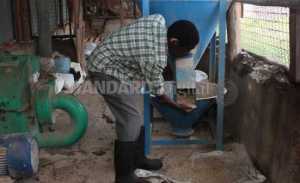Animal feed serves up one of the biggest headaches for farmers. Actually, feeds account for more than 60 per cent of total production costs. But one farmer has gotten his way around this. James Nyamai, an engineer, has mastered how to make his own chicken feed saving himself significant production costs.
At his small factory, African Green Farm in Machakos County, Nyamai makes feeds for his 2,300 chicken.
“My magic formula basically contains a bit of wheat pollard, maize, sunflower cake, salt and cotton cake which I mix in certain rations,” says the 31-year-old farmer who started farming four years ago. Before he ventured into farming, Nyamai was employed as a production engineer.
“Like many young graduates, I went into employment after graduation. I got a well-paying job that I did for a while, but I was not getting the job satisfaction I desired. So I quit,” he says. Lucky for him, while he was still employed, he was doing farming as a side hustle.
“I was already keeping 440 chicken and growing tomatoes, capsicum (hoho), onions, spinach and sukuma wiki,” he says.
Nyamai’s moment of reckoning came when he passed an interview for a new job and was told he got the position only to realise later that somebody else had been given the job.
“I was so devastated. It hit me that employment has no job security. That’s when I decided to venture into my passion full time,” he says.

In May 2012, he took the plunge and resigned from his job as a production engineer. Other than that, another reason he decided to quit was the massive losses he was facing from the farm due to mismanagement.
“The person that I had employed was really mismanaging the farm. I was making no profit and the expenses were not adding up. I realised if I want my agribusiness to kick off, I had to manage it myself,” he says.
Using his savings, he increased his broilers from 1,000 to 2,300 birds and ventured into commercial farming in 2014. He now sells chicken to nearby hotels, individual farmers and institutions. After running the project for a while, he discovered that buying chicken feed was eating into his profits.
“I realised buying chicken feed was too expensive, especially if you factor in the Value Added Tax on feeds. I had to find a way out. So I embarked on a research on how to make my own feeds,” he says.
So for three months, the engineer researched on the ingredients, the best breeds for the area and more on the best Feed Conversion Ratio, the amount of feed you give to the bird vis a vis the meat a farmer gets from the bird. This is critical when considering the breed to keep, he says. After extensive research, he managed to come up with the perfect ration. Using his engineering background he also developed an application to ensure the rations are constant all the time.
“I feed in the current prices of ingredients and specifications of the particular breed I am keeping at the time in the programme. The programme then calculates the ingredients I’ll use, giving me the best combination of ingredients that will make sure the nutritional requirements are met, at the lowest price,” he explains.
To ensure the ingredients have the right nutrients in the correct percentages, he takes them to different laboratories in Nairobi for analysis. They are analysed for the levels of crude protein, energy, amino acids, fibre and mineral salts.
He also bought a machine to aid in mixing of the ingredients. Now he is able to save between Sh15 to Sh20 per kilo of feed and is in the process of getting Kenya Bureau of Standards mark of quality to commercialise on his invention.
So what about farmers who would also want to make their own feed? He says a small-scale farmer can choose to make their own feeds, but if they do not have the technical know-how, he would be willing to share his knowledge, or they can look for a nutritionist to advise them on the quality and type of ingredients to use. He, however, cautions that, “making your own feeds as a farmer can be beneficial, but can also be costly if you do not find the right raw materials at a competitive price.”
One also has to be careful to get the ingredients from the right source. “Some people might mix the ingredients with other things like sand, so the wrong ingredients might cause problems like retarded growth in chicken,” he cautions.
Nyamai has also learnt some precious farming gems.
“When I started, I used a manual incubator to hatch the eggs, and you have to keep on turning the eggs, checking water level for humidity and temperature. If it goes above 37 degrees it burns the chicks in the eggs and below 30 degrees they will die of cold,” he says. His problems were sorted when he invested in an electric incubator.
“It automatically turns the eggs, and you set the temperature and humidity that you want and it regulates itself, so I just used to come in the evening and check the water, which you replace after 24 hours,” he says.
Even when there are power outages, the electric incubator has insulation which enables it last eight hours without electricity.
However, he says power in Machakos is unreliable, so it is not foolproof. “I incurred losses twice when a transformer blew and both times it took three days to fix it, so I threw away the eggs that I had bought. That taught me that I needed a generator,” he says.

